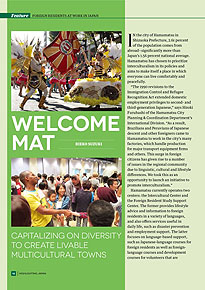Home > Highlighting JAPAN >Highlighting Japan October 2014>Foreign residents at work in Japan
Highlighting JAPAN

Foreign residents at work in Japan
Welcome Mat
Capitalizing on diversity to create livable multicultural towns

In the city of Hamamatsu in Shizuoka Prefecture, 2.61 percent of the population comes from abroad—significantly more than Japan’s 1.56 percent national average. Hamamatsu has chosen to prioritize interculturalism in its policies and aims to make itself a place in which everyone can live comfortably and peacefully.
“The 1990 revisions to the Immigration Control and Refugee Recognition Act extended domestic employment privileges to second- and third-generation Japanese,” says Hiroki Furuhashi of the Hamamatsu City Planning & Coordination Department’s International Division. “As a result, Brazilians and Peruvians of Japanese descent and other foreigners came to Hamamatsu to work in the city’s many factories, which handle production for major transport equipment firms and others. This surge in foreign citizens has given rise to a number of issues in the regional community due to linguistic, cultural and lifestyle differences. We took this as an opportunity to launch an initiative to promote interculturalism.”
Hamamatsu currently operates two centers: the Intercultural Center and the Foreign Resident Study Support Center. The former provides lifestyle advice and information to foreign residents in a variety of languages, and also offers services useful in daily life, such as disaster prevention and employment support. The latter focuses on language-based support, such as Japanese-language courses for foreign residents as well as foreign-language courses and development courses for volunteers that are providing Japanese-language assistance to foreign residents.
Hamamatsu has also established many resources to answer questions from foreign citizens and put them more at ease. One is the city’s Canal Hamamatsu website, which offers a broad range of information on medical care, education, welfare, transportation and so on in six languages. Two others are “Disaster Prevention Email”—offered in three languages—and a welcome pack of pamphlets that offer advice in two languages on everything from methods of garbage collection to taxes.
“To achieve our goal of interculturalism, Japanese and foreign citizens must meet each other halfway and reach a mutual understanding,” Furuhashi states. “Foreign citizens study and deliberate issues and provide recommendations on various problems and how to promote intercultural harmony with Japanese citizens as members of our Foreign Resident Committee. We also founded a Conference to Promote Interculturalism, which assists intercultural city planning and receives support from a wide variety of community representatives and organizations to encourage multiculturalism.”
Amidst the Lehman Shock and the Great East Japan Earthquake, the city’s foreign population peaked at 2008, and has been in a state of decline ever since. Nevertheless, the percentage of foreign students at the city’s elementary and middle schools has stayed virtually the same—a sign that Hamamatsu’s foreign residents had chosen to start families in the city and live there permanently. An initiative was launched to provide better educational support to the children of foreign residents.
“Based on a fact-finding investigation regarding residency, a project involving analysis of the reasons for school nonattendance, attentive case-by-case support, and follow-up surveys began in 2011. Called the ‘zero non-enrollment’ policy, it is meant to ensure that no child of school age is and never will be left out of school,” Furuhashi says. “In September of last year, we achieved that benchmark. Our support model, known as the ‘Hamamatsu model,’ is being considered by other municipalities all over Japan.”
In 2001, to encourage a more multicultural society, and acting on a proposal from Hamamatsu, the Council for Cities with Non-Japanese Residents was created as a way for municipalities with large numbers of foreign citizens to work together to devise proposals to submit to the Japanese government and other organizations and to solve problems. By hosting the Asia-Europe Intercultural City Summit in 2012 and participating in the global network United Cities and Local Governments, Hamamatsu came up with interculturalism initiatives and city planning that take advantage of multiculturalism.
“As a society with a decreasing birth rate, it is becoming essential to maintain the vitality of our cities through urban planning that capitalizes on the diverse power of foreign citizens,” Furuhashi proclaims. “By enacting policies that focus on our existing support centers and engaging in urban planning that takes advantage of diversity and encourages citizen participation, Hamamatsu will become the intercultural city we want it to be.”
© 2009 Cabinet Office, Government of Japan






